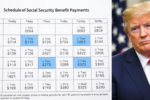For retired couples, Social Security spousal benefits can play a critical role in ensuring financial security. Understanding these benefits can help maximize retirement income and avoid common mistakes. Here are four essential things retired couples should know about Social Security spousal benefits in 2025.
1. Eligibility for Spousal Benefits
Spousal benefits allow one spouse to receive up to 50% of the other spouse’s full retirement age (FRA) benefit amount. To qualify, you must meet the following criteria:
- You and your spouse must have been married for at least one year.
- Your spouse must be eligible for Social Security benefits.
- You must be at least 62 years old to claim spousal benefits.
It’s important to note that you can’t receive both your own retirement benefits and spousal benefits in full. The Social Security Administration (SSA) will pay the higher of the two amounts. This rule is especially crucial for couples with varying income levels, as it can impact overall household income.
2. Timing Matters for Maximum Benefits
When you choose to claim spousal benefits can significantly affect the amount you receive. Here’s how timing works:
- Claiming at age 62 will reduce your spousal benefits to as little as 32.5% of your spouse’s FRA benefit.
- Waiting until your own FRA ensures you receive the full 50% benefit amount.
- Delaying beyond FRA will not increase spousal benefits; however, it could maximize your own retirement benefits.
For couples, strategic timing is key. For example, one spouse could delay claiming their own benefits to allow them to grow through delayed retirement credits while the other claims spousal benefits to provide income in the interim.
3. Impact of Divorces and Remarriages
Spousal benefits aren’t limited to current marriages. If you’re divorced but were married for at least 10 years, you may still qualify for spousal benefits based on your ex-spouse’s earnings record. Here’s what to keep in mind:
- You must remain unmarried to claim benefits based on your ex-spouse’s record.
- Your ex-spouse does not need to have started claiming benefits for you to qualify, as long as they are eligible.
If you remarry, your eligibility for benefits based on your ex-spouse’s record ends. However, you may become eligible for spousal benefits based on your new spouse’s record. This can lead to complex planning scenarios, so consulting a financial advisor is recommended.
4. Survivor Benefits vs. Spousal Benefits
Survivor benefits and spousal benefits are often confused, but they serve different purposes. Survivor benefits allow a surviving spouse to receive up to 100% of the deceased spouse’s benefit, depending on the survivor’s age at the time of claiming. Here are the key differences:
- Spousal benefits max out at 50% of the working spouse’s FRA benefit, while survivor benefits can equal 100%.
- If your spouse passes away, you cannot collect both survivor benefits and your own retirement benefits. The SSA will pay the higher of the two amounts.
- Survivor benefits can be claimed as early as age 60 (or 50 if disabled), but claiming early will reduce the benefit amount.
Retired couples should factor survivor benefits into their overall retirement plan, as these benefits can provide critical financial support in the event of a spouse’s death.
Why Spousal Benefits Are Crucial for Retirement Planning
Understanding Social Security spousal benefits can significantly enhance your retirement strategy. Here are a few tips for optimizing these benefits:
- Coordinate with Your Spouse: Discuss your claiming strategies to maximize household income.
- Factor in Longevity: If one spouse is expected to live significantly longer, it may make sense for the higher earner to delay claiming benefits to maximize survivor benefits.
- Work with a Financial Advisor: The rules surrounding spousal and survivor benefits can be complex. A professional can help you navigate the options and avoid costly mistakes.
For more detailed guidance on Social Security benefits, visit the Social Security Administration’s official website.
Conclusion
Social Security spousal benefits are an essential component of retirement income for many couples. By understanding eligibility, timing, and the differences between spousal and survivor benefits, you can make informed decisions that support your long-term financial goals. Whether you’re newly retired or planning ahead, taking the time to understand these benefits can provide peace of mind and financial stability.
Disclaimer – Our team has carefully fact-checked this article to make sure it’s accurate and free from any misinformation. We’re dedicated to keeping our content honest and reliable for our readers.







